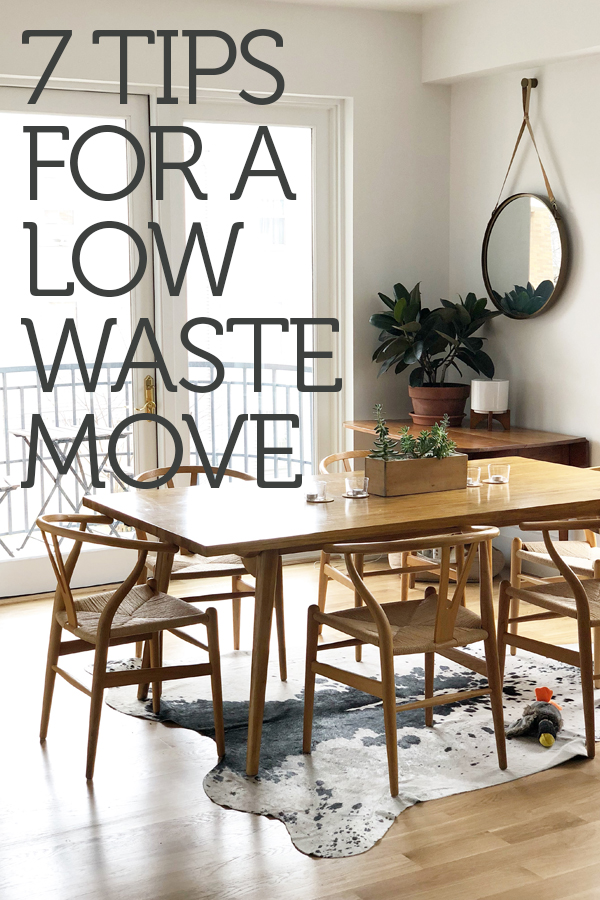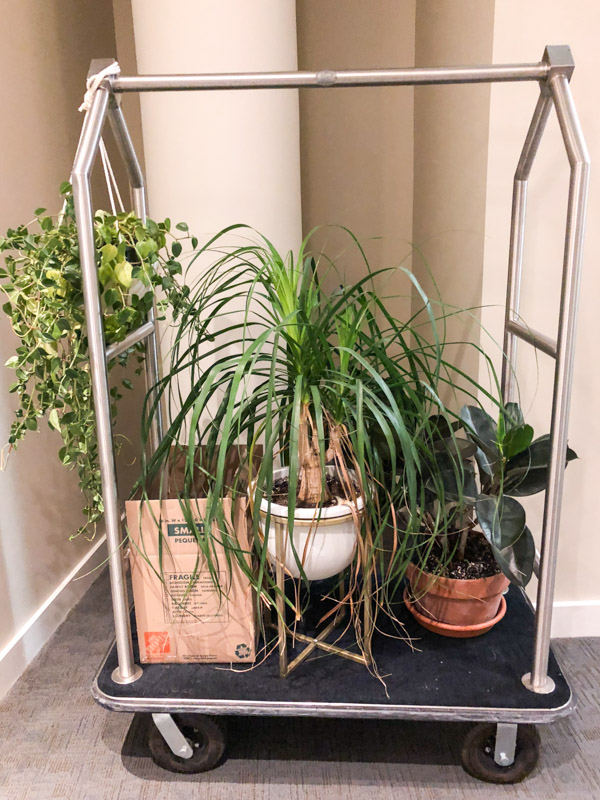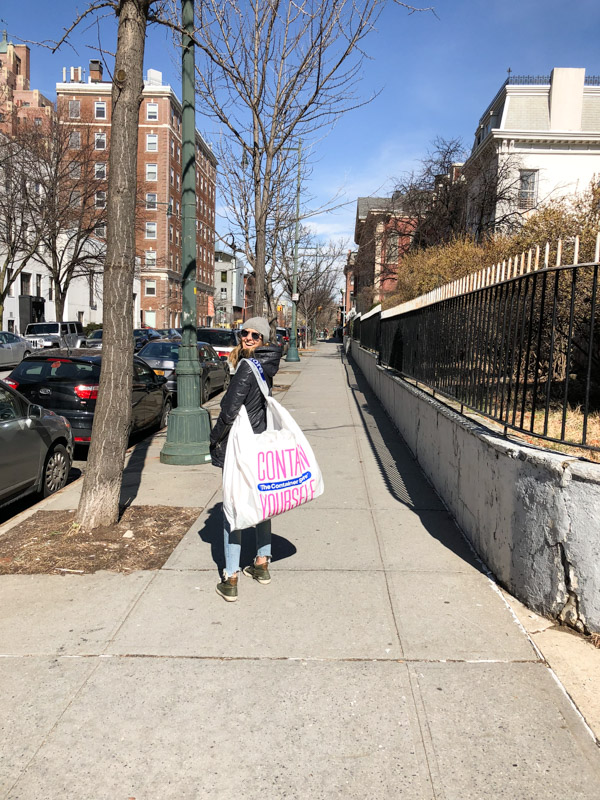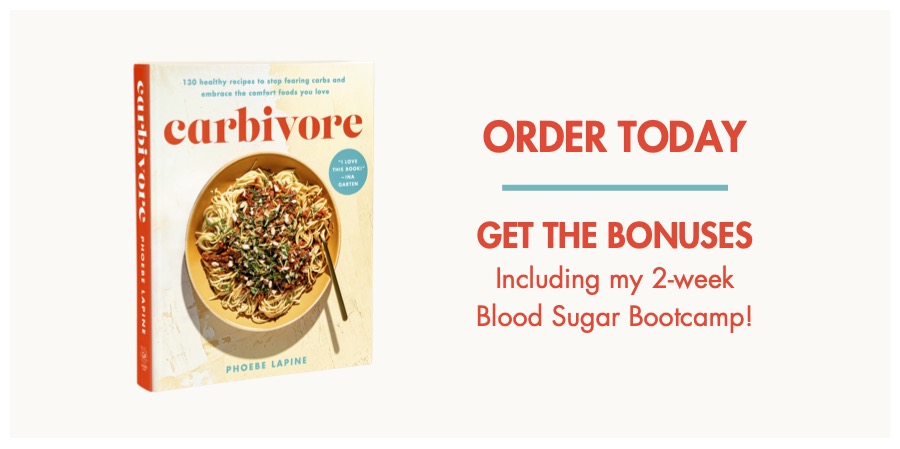No matter how exciting your inevitable destination, moving is the worst.
It’s exhausting. It’s expensive. And if it’s not expensive, then it’s even more exhausting.
At the same time, it’s also a productive exercise. One that forces you to reckon with your true material burden and answer important existential questions, like: will I ever truly need these cat print leggings? Will I ever again watch this deluxe edition American Pie DVD?
Ever since No Waste Month, Charlie and I have been better about simplifying our life. We’ve pruned our belongings throughout the year and given the joyless dead weight to Goodwill. We’ve upcycled useless knickknacks that were always destined for landfill by shipping them off to Teracycle. And yet, by the last day of February, we were still sitting in a sea of boxes, drowning under the weight of our “stuff.”
Of course, just as we vowed not to buy any more of it, we arrived in our new space needing this and that. Our television was suddenly too small. Our shelves were too deep, and in need of organizers. Our additional bedroom completely empty.
Nothing is more contrary to the no waste mission than constant consumerism. So suffice it to say, there’s a been a lot in the last few weeks around our move and subsequent nesting phase that has been making me feel guilty.
When you’re exhausted, behind schedule, overwhelmed (and sick, as I became the morning after the movers came), it’s all too tempting to take the easy way out. To pay the money, to toss the moldy yogurt containers at the back of your fridge in the trash.
There were certain waste-free habits we managed to stick with, and others that fell by the wayside in the name of convenience. Such are the high-high’s and low low’s of healthy hedonism. As always, in the spirit of my chosen “balance,” I am trying to accept my shortcomings, yet am still striving to be better.
Which is why I’m so excited to share with you some of my small victories, things I wish I had done in hindsight, and other tips on how you can get through your move alive and still produce less waste in the process.
The last tip has been the source of many of your Instagram questions, so read on!
With health and hedonism,
Phoebe
7 TIPS FOR A LOW WASTE MOVE
One tactic that will help you both produce less waste AND have a less stressful move is to do some pruning before the packing materials even arrive. I’m not talking about a Marie Kondo-style joy-off. A few weeks out, simply go through all your drawers—in the kitchen, in the bedroom, and beyond—and do an initial skimming of the crap.
Clothing can be donated or sold on second hand websites like Swap, Tradesy, The Real Real or a local consignment shop. Larger furniture can be scheduled for pick-up by Salvation Army, Goodwill, or Housing Works. If you want to try to sell it, get it up on Craig’s list or AptDeco early, and be willing to vastly reduce the price as your move date approaches.
In terms of food, anything unopened can be put in a pile for a soup kitchen. Old moldy condiments at the back of the fridge can be composted or washed down the drain, making sure to either recycle or reuse the jars and bottles whenever possible. We also challenged ourselves in the weeks before our move to not buy any new pantry items (and minimal fresh groceries) so we could make use of just what we had.
Re-Use Boxes from a Local Retailer
For two moves now, I’ve sourced almost half my boxes from my neighborhood wine shop. If you think about it: they receive a ton of boxes for their inventory, which all tend to be reasonably uniform in size, and come with cardboard dividers that are perfect for kitchen items. Not only did we pack up our actual wine bottles in these, but we also used them for nearly the entire kitchen—jars, glasses, prep bowls, etc.—and it majorly cut down on the amount of packing paper we used. Aside from the few casualties (my beloved horse show glasses!) everything made it intact. Grocery stores are also a great resource for boxes, though they tend to be a mixed bag in terms of what sizes you’ll get.
If you don’t opt for used boxes, at least try to purchase boxes that are made from recycled materials. Home Depot has this option. For an even more eco-friendly route, check out Rent a Green Box, which will send you containers for your move (along with a host of other eco-friendly packing supplies) and pick them up. I wish we had used them!
Opt for Newspaper Instead of Packing Paper
As far as moving waste goes, packing paper is not top of the worry list, especially if you buy a roll made from recycled paper. But you can also save yourself a little money buy sourcing day-old newspapers from a local stand or store. If you don’t want the ink touching your dishware, you can at least bunch it up and use as padding for boxes. Which brings me to another tip…
Use Real Peanuts Instead of Packing Peanuts
Ok, maybe not in the way you’re thinking. But the random boxes and bags of grains, nuts, and pasta in our pantry were perfect lightweight materials to use as padding for the more fragile stuff. As much as I am fairly anal and like to keep my boxes as organized (like with like) as possible, there were many instances where we had extra room at the top of boxes containing precarious items and needed something bulky to cushion and stabilize them. That was the point where we began throwing random bags of gluten-free flour and chia seeds at the problem.
Extra dish rags, towels, linens (and of course clothes) also work well for this purpose, but then you’re really mixing up areas of the house.
Hoard Spare Bags
A giant duffle bag is a good long-term investment. At some point, your child will likely need it for camp or college. In the present, you might need it to cart all your clothing from one place to another. Ikea blue bags are also fantastic for this purpose. Throw your shoes and bathroom products in one of these giant wide-berth bags, and pack clothing, linens and other soft items in the storage bags with a zipper.
This not only saves boxes, but it also saves space. If you are using a moving company, you can also ask if you can leave your clothes in the drawers and tape them shut.
Extra suit bags are also incredibly handy for transporting hung items so you don’t need to waste time taking dresses off hangers and folding wrinkle-prone clothing.
Return Wire Hangers to the Dry Cleaner
If you use a dry cleaner, and have not learned your lesson from watching Mommy Dearest, chances are you’ve accumulated quite a few wire hangers in your closet. Try to consolidate your clothing onto the wood / “real” hangers and return the pile of metal ones to your local dry cleaner. They will appreciate it.
Recycle Soft Plastic
After No Waste Month, we started collecting our soft plastics in a canvas tote and bringing them in to be recycled every other month. The plastic is clean and scentless (or it should be!), so we always managed to pack a lot of it into a small bag, meaning it’s a pretty low hassle aspect of our recycling routine.
In New York State (and many others), large retailers are required by law to recycle soft plastic bags and film plastic. You can save your plastic grocery bags, mailer sleeves, non-food soiled plastic wrapping, and sleeves and bring them into a location here.
This also includes newspaper bags, dry cleaning plastic, and thin plastic film from notecards, tea boxes, pre-packaged cheese, household items, pet food, and juice packs. No doubt many other states also have similar options. It’s worth checking out.
In buying new items for the house, we accumulated plenty of soft plastic along the way, and I was proud that even amidst all the hurdles of moving, we were able to stick to our commitments of recycling it. (In a very large Container Store bag!)
Additional Resources:
- TerraCycle offers mail-in programs for 50 to 60 different materials that aren’t easily recyclable, like snack packs, granola bar wrappers, chip bags and drink pouches. Their mixed use Zero Waste box was a life saver (or, er, waste saver) during the move.
- This Earth911 article also has great suggestions.
- Lauren Singer is a model citizen for all aspects of low waste, minimal living.
- For more advice and resources, check out Emma Loewe’s archive on Mind Body Green.
Have any tips for going zero waste while moving? Please leave them in the comments section!




A couple things:
1–if you’re at a university with a science department, check for boxes at their stockroom, usually in a basement somewhere. It’s a great way to get boxes that are all sized the same, clean. If you’re nice and polite, they’ll usually save them for you if you ask, as well.
2–If you’re doing a local move and have access to a car, the biggest moving saver for kitchen things is bankers boxes cushioned with every single dishtowel and microfiber cloth you own. I’m in the midst of a move right now, and taking over carloads is so much less painful than carefully wrapping every last dish and dealing with bubble wrap and tape. Bankers boxes in particular are a great option size-wise since plates and other ceramics are so heavy – it means you are for sure not going to bust through them, and it’s a size that still allows you to carry what you have.
3–Before your actual day of moving, pack a suitcase with everything you’ll need for the next three days, including toiletries. (This avoids unnecessary stress / re-buying of things)
this is so awesome Bridget!! thank you for sharing! we definitely did a lot of trips ourself in the car before the movers took the furniture. Need to look into banker boxes!
Carloads do make it easier! (Though still tiring. Moves are no joke).
Good luck as you continue to settle in!
This article is very useful to all the readers. Your tips are very helpful especially that of recycling and reusing the old things. I would like to share your great tips with my friends. Keep posting such helpful articles.
Loved your post. It very important to take care of the environment and recycle as most as possible.
so glad you agree!
Excellent suggestions! I’ve read a lot of posts and blogs about moving and this is the first one that talks about reducing waste efficiently.
so glad you found it helpful! happy moving!
Great advice. We must reduce our carbon footprint. Thank you!
glad it was helpful. agreed!
Wow, excellent advice. I found your website just right for my needs. Thanks for sharing the great information. Good Luck!
Use recycled boxes! No need to buy new ones, when you can hitup the stores for used ones?